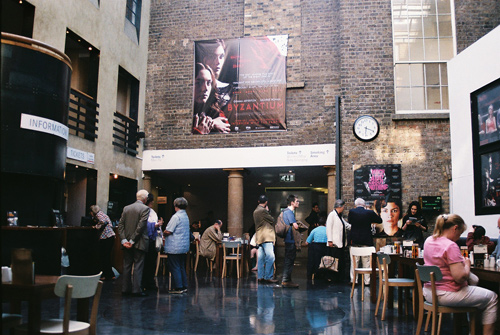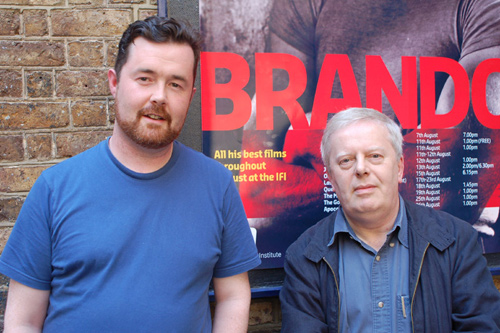David Lean’s Film of “Ryan’s Daughter” Photographed in
Super Panavision 70 by Freddie Young, BSC |
Read more at in70mm.com The 70mm Newsletter |
| Written by: Brian Guckian. Photos (35mm) by the writer | Date: 03.08.2013 |
 Poster
advertising mini-season of 70mm screenings Poster
advertising mini-season of 70mm screeningsCinemagoers were treated to a rare 70mm screening of David Lean’s underrated "Ryan's Daughter" at the Irish Film Institute in Dublin this June, from a print held by the Swedish Film Institute. In English with Swedish subtitles, the print was in excellent condition, with little or no colour fading, and provided an ideal opportunity to encounter anew Freddie Young, BSC’s outstanding cinematography on what was to be Lean’s penultimate work. It is a pity that much of the discussion about this film has centred on the circumstances of its production and in particular the economic bonanza it brought at the time to the local community on the Dingle Peninsula, at the southwest tip of the country. This has been to the detriment of the film’s story and themes, which to this writer seem intimately bound to the political background of the time in which it was made, additional to the historical political events alluded to in the film. |
More in 70mm reading: 70mm In the Emerald Isle Memories of Ryan's Daughter Todd-AO & Cinerama in Ireland Tuairisc Todd-AO agus Cinerama in Éirinn On the trail of "Ryan's Daughter" & "Far and Away" 65/70mm Workshop DP70 / Universal 70-35 / Norelco AAII - The Todd-AO Projector Internet link: Pete Walsh Irish Film Institute |
 The
lobby prior to the screening. The poster advertises the most recent film
from Irish director Neil Jordan The
lobby prior to the screening. The poster advertises the most recent film
from Irish director Neil JordanAcademic writing on “Ryan’s Daughter” has possibly picked up on this aspect. The film and its production could be read as a metaphor for the Irish-British relationship: as well as the obvious symbolism of the presence in the area of the film crew (particularly in light of the politics of the time) and the massive set construction and shooting effort, the final scenes where Shaughnessy and Rosy are forced to flee the village of Kirrary play more like a cameo of the expulsion of foreign occupiers than the casting out of members of the community. Likewise, the essential Englishness of Rosy in the film – intriguingly permitted by Lean – makes her seem more like an interloper than the daughter of the village publican (whose own role as an informer seems more than coincidental). Meanwhile Trevor Howard plays the parish priest far more like a stern Protestant minister than the worldly Catholic prelate beloved of cinematic cliché. |
|
 Gate
of one of pair of Cinemeccanica Vic8 35/70mm projectors installed June 2012
replacing Philips DP70 (now in storage) Gate
of one of pair of Cinemeccanica Vic8 35/70mm projectors installed June 2012
replacing Philips DP70 (now in storage)It may be because of these political complexities and sensitivities (perhaps obscured over the years by the film’s overt romantic themes) that “Ryan’s Daughter” is rarely screened in Ireland, and even rarer still in the 70mm format it should be seen in. This is a shame, because like other 65mm-photographed titles – exemplified most recently by Paul Thomas Anderson’s “The Master” (inexplicably still withheld from release on 70mm in Ireland) – the film can only fully be appreciated this way. Despite the more than 40 years that separate “Ryan’s Daughter” and Anderson’s work, interesting similarities are apparent in both Directors’ use of close-ups in 65mm to provide greater intimacy, a heightened emotional response and deeper engagement with the story. Also, together with the powerful and well-known storm sequence, several dramatic shots portraying Major Doryan in silhouette recalled, for this writer, the cinematography of Michael Powell’s “The Edge of the World” (1937), with its similar remote coastal setting. |
|
 Flight
case with reel #8 of "Ryan's Dotter" Flight
case with reel #8 of "Ryan's Dotter"Like Anderson’s recent film, Lean’s masterfully-crafted work really plays as an epic of the interior, an approach born of the influence of Flaubert’s “Madame Bovary” on Robert Bolt’s screenplay. A misunderstanding about this introspection (as with “The Master”) may account for the negative reviews the film received on release, particularly given the previous outward scale of “Doctor Zhivago” and “Lawrence of Arabia”. Captivating and rewarding, “Ryan’s Daughter” exemplifies a lost era of meticulously-crafted, adult-oriented Cinema, underscoring the critical importance of these works continuing to be available in the format they were meant to be seen in, not only generally, but especially also for students of cinema and the filmmaking arts. (Note: Additional photos that were taken for this piece are currently awaiting copyright approval) |
|
In Memoriam – Peter (Pete) Walsh 1950 – 2012 |
|
 Brian
(left) and Pete 25 August 2007. Image by Thomas Hauerslev Brian
(left) and Pete 25 August 2007. Image by Thomas HauerslevThe continuing ability to see 70mm prints in Ireland today is down to the determined, progressive work of Peter (Pete) Walsh, late Cinemas Programmer at the Irish Film Institute. On his appointment in 1994, he quickly made significant improvements to the Institute's auditoria, which, along with his erudite programming skills, significantly increased the audience for arthouse, repertory and classic cinema in Dublin. A devotee of 70mm, among his many accomplishments was the acquisition of a pair of Philips DP70s from the former Curzon West End (formerly Columbia) cinema in London, one of which was installed in the main auditorium at the IFI and the other retained for spares. As well as mainstream fare, Pete was also interested in 70mm shorts and experimental pieces, and he had a deep and abiding appreciation of the artistic aspects of the medium. Prior to tragically falling seriously ill last summer, he ensured continuing and expanded access to 70mm prints via the installation of twin 35/70mm Cinemeccanica Victoria 8 projectors (necessary in part due to 35mm silent film capability requirements), and was constantly making improvements to projection quality at the IFI Cinemas. I was privileged to know Pete Walsh over 15 years. A thoughtful, generous, intelligent and humorous man, with a lifelong dedication to the appreciation and understanding of Cinema, its history and traditions, his untimely passing last December came as a shock to many. A fuller appreciation of Pete is reproduced here |
|
| Go: back - top - back issues - news index Updated 22-01-25 |
